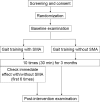Efficacy of Wearable Device Gait Training on Parkinson's Disease: A Randomized Controlled Open-label Pilot Study
- PMID: 35135928
- PMCID: PMC9492471
- DOI: 10.2169/internalmedicine.8949-21
Efficacy of Wearable Device Gait Training on Parkinson's Disease: A Randomized Controlled Open-label Pilot Study
Abstract
Objective To investigate the efficacy of home-based gait training using the wearable Stride Management Assist (SMA) exoskeleton in people with moderately advanced Parkinson's disease. Methods This was a single-center, open-label, parallel, randomized controlled trial. We included outpatients with idiopathic Parkinson's disease who were capable of walking independently with or without walk aids and had Hoehn and Yahr stage 2-4 in the ON state. Patients were randomly assigned (1:1 ratio) to receive either SMA gait training (SMA group) or control gait training (control group). All participants underwent gait training for approximately 30 min. These training sessions were conducted 10 times for 3 months. We measured clinical outcomes at baseline and post-intervention. The between-group difference of distance in the three-minute walk test was the primary outcome. Results Of the 15 randomly assigned participants, 12 (five in the SMA group) completed this study. The between-group difference was a mean of 13.7 meters (standard error of the mean: 7.8) in the 3-minute walk test (p=0.109). The distance traversed increased from 141.4 m to 154.7 m in the SMA group (p=0.023), whereas there was no marked change in the control group. In addition, although there was a decrease in the physiological cost index from 0.29 to 0.13 in the SMA group (p=0.046), it remained unchanged in the control group. Conclusion These findings suggest that home-based SMA gait training may increase the exercise endurance in people with moderately advanced Parkinson's disease.
Keywords: Parkinson's disease; clinical trial; gait training; randomized controlled; rehabilitation; wearable robot.
Conflict of interest statement
Figures
Similar articles
-
Clinical effects of robot-assisted gait training and treadmill training for Parkinson's disease. A randomized controlled trial.Ann Phys Rehabil Med. 2019 Sep;62(5):303-312. doi: 10.1016/j.rehab.2019.06.016. Epub 2019 Aug 1. Ann Phys Rehabil Med. 2019. PMID: 31377382 Clinical Trial.
-
Wearable biofeedback device to assess gait features and improve gait pattern in people with parkinson's disease: a case series.J Neuroeng Rehabil. 2024 Jun 26;21(1):110. doi: 10.1186/s12984-024-01403-z. J Neuroeng Rehabil. 2024. PMID: 38926876 Free PMC article.
-
Visual cues combined with treadmill training to improve gait performance in Parkinson's disease: a pilot randomized controlled trial.Clin Rehabil. 2016 May;30(5):463-71. doi: 10.1177/0269215515588836. Epub 2015 Jun 2. Clin Rehabil. 2016. PMID: 26038610 Clinical Trial.
-
Wearable technological platform for multidomain diagnostic and exercise interventions in Parkinson's disease.Int Rev Neurobiol. 2019;147:75-93. doi: 10.1016/bs.irn.2019.08.004. Epub 2019 Sep 16. Int Rev Neurobiol. 2019. PMID: 31607363 Review.
-
Effects of robot-assisted gait training on postural instability in Parkinson's disease: a systematic review.Eur J Phys Rehabil Med. 2021 Jun;57(3):472-477. doi: 10.23736/S1973-9087.21.06939-2. Epub 2021 Apr 7. Eur J Phys Rehabil Med. 2021. PMID: 33826278
Cited by
-
80N as the Optimal Assistive Threshold for Wearable Exoskeleton-Mediated Gait Rehabilitation in Parkinson's Disease: A Prospective Biomarker Validation Study.Healthcare (Basel). 2025 Apr 2;13(7):799. doi: 10.3390/healthcare13070799. Healthcare (Basel). 2025. PMID: 40218096 Free PMC article.
-
Assisted technology in Parkinson's disease gait: what's up?Arq Neuropsiquiatr. 2024 Jun;82(6):1-10. doi: 10.1055/s-0043-1777782. Epub 2024 Feb 23. Arq Neuropsiquiatr. 2024. PMID: 38395424 Free PMC article. Review.
-
Effectiveness of robot-assisted training in adults with Parkinson's disease: a systematic review and meta-analysis.J Neurol. 2024 Dec 12;272(1):22. doi: 10.1007/s00415-024-12798-z. J Neurol. 2024. PMID: 39666104
-
Impact of Wearable Device-Based Walking Programs on Gait Speed in Older Adults: A Systematic Review and Meta-Analysis.Geriatr Orthop Surg Rehabil. 2024 Sep 16;15:21514593241284473. doi: 10.1177/21514593241284473. eCollection 2024. Geriatr Orthop Surg Rehabil. 2024. PMID: 39290341 Free PMC article. Review.
-
Better Understanding Rehabilitation of Motor Symptoms: Insights from the Use of Wearables.Pragmat Obs Res. 2025 Mar 19;16:67-93. doi: 10.2147/POR.S396198. eCollection 2025. Pragmat Obs Res. 2025. PMID: 40125472 Free PMC article. Review.
References
-
- Kalia LV, Lang AE. Parkinson's disease. Lancet 386: 896-912, 2015. - PubMed
-
- Shulman LM, Gruber-Baldini AL, Anderson KE, et al. . The evolution of disability in Parkinson disease. Mov Disord 23: 790-796, 2008. - PubMed
-
- Abbruzzese G, Marchese R, Avanzino L, Pelosin E. Rehabilitation for Parkinson's disease: current outlook and future challenges. Parkinsonism Relat Disord 22: S60-S64, 2016. - PubMed
-
- Kolk NM, King LA. Effects of exercise on mobility in people with Parkinson's disease. Mov Disord 28: 1587-1596, 2013. - PubMed
Publication types
MeSH terms
LinkOut - more resources
Full Text Sources
Medical
Miscellaneous




